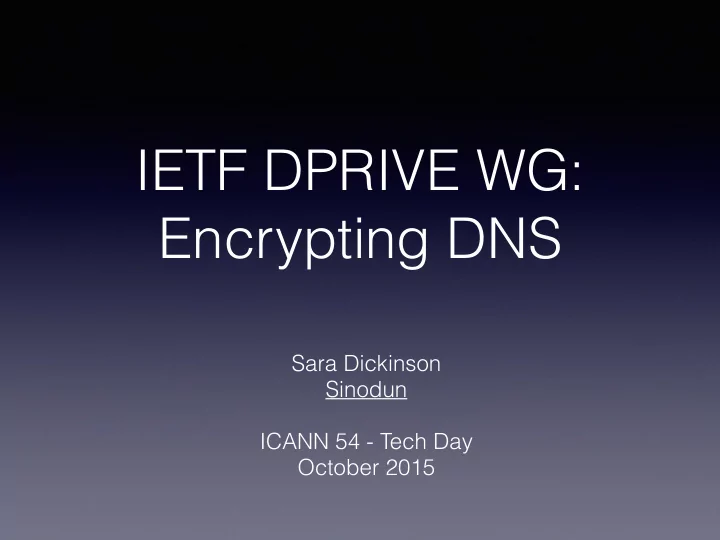

IETF DPRIVE WG: Encrypting DNS Sara Dickinson Sinodun ICANN 54 - Tech Day October 2015
DPRIVE WG Focus is stub to recursive Group IETF92 IETF91 IETF93 created A ID: problem-statement RFC7626 ID: dns-tls-newport A ID: start-tls-for-dns ID: start-tls-for-dns ID:dns-over-tls STARTTLS & port Early port allocation A ID: dnsodtls ID: dnsodtls 2014 2015 Q4 Q1 Q3 Q2 Q4 TIME
Pros and Cons Pros Cons • Port 53 - middleboxes? • Port 53 • Existing TCP implementations • Known technique STARTTLS • Downgrade attack on negotiation • Incrementation deployment • Latency from negotiation • New DNS port (no TLS • New port assignment interference with port 53) (new port) • Existing implementations • Truncation of DNS messages • UDP based (just like UDP) DTLS • Certain performance ➡ Fallback to clear text or TLS aspects ❌ Can’t be standalone solution • No running code
Early port allocation • 8th October 2015 - IANA assigned port 853 : domain-s 853 tcp DNS query-response protocol run over TLS/DTLS domain-s 853 udp DNS query-response protocol run over TLS/DTLS
DNS-over-TLS needs TCP ! • DNS-over-TCP… historically used only as a fallback transport (TC=1 ➡ ‘one-shot’ TCP, Zone transfer) • 2010: RFC5966 - TCP a requirement for DNS implementations • 2014: Connection-oriented DNS - USC/ISI paper • draft-ietf-dnsop-5966bis • performance on par with UDP, security/robustness • draft-ietf-dnsop-edns-tcp-keepalive - persistent TCP connections
TCP/TLS Performance Goals : 1. Handle many TCP connections robustly 2. Optimise TCP/TLS set up & resumption • TCP FastOpen, TLS resumption, [TLS 1.3] 3. Amortise cost of TCP/TLS setup • Send many messages efficiently
Performance (5966bis) Client - Query pipelining connection re-use pipelining q1, q2 q1, q2 q1 q1 q2 delayed q2 waiting for q1 a1 a1 (+1 RTT) a2 q2 0 extra (recursive) RTT a2 (stub)
Performance (5966bis) Server - concurrent processing of requests sending of out of order responses in-order concurrent, OOOR R A R A q1, q2 q1 q1, q2 q1 q2 q2 q2 delayed waiting for q1 0 extra a2 (+1 RTT) RTT a1 a1 reply as soon stub as possible a2
DNS-over-TLS implementations • Unbound 1.4.14 (2011) - DNSTrigger • TLS patches for LDNS and NSD • [BIND TCP improvements] • getdns - ongoing development of DNS-over-TLS
• Modern async DNSSEC enabled API • https://getdnsapi.net • Stub mode has TLS with flexible privacy policy and fallback: Strict (Authenticated) TLS only Opportunistic TLS Fallback to TCP, UDP • Pipelining, OOOP, Configurable idle time
Current status Software digit LDNS getdns Unbound NSD BIND client server/ mode client stub server client server recursive* (drill) client TLS TFO Conn reuse Pipelining OOOP Dark Green: Latest stable release supports this Light Green: Patch available Yellow: Patch in progress, or requires building a patched dependancy Grey: Not applicable or not planned * getdns uses libunbound in recursive mode
TLS BCP • UTA (Using TLS in Applications) WG produced DNS-over-TLS is relatively RFC7525 this year - “BCP for TLS and DTLS” ‘green-field’ • Key recommendations - Protocol versions: • TLS v1.2 MUST be supported and preferred • Recommended Cipher Suites (4 of ~100): • AEAD mode - Forward secrecy for key exchange • TLS_ECDHE_RSA_WITH_AES_128_GCM_SHA256
TLS BCP - Authentication • Secure discovery of certificate/hostname/etc. • For DNS-over-TLS? • Pre-deployed configuration profile • DANE… (clear-text or un-authenticated TLS) • boot strap problem
Summary • Active work on encrypting DNS in DPRIVE • For DNS-over-TLS performance is key • Client should consider privacy policy • see Appendix for stub/recursive examples • Know your (D)TLS Best Current Practices
Thank you! Any Questions? sara@sinodun.com
Appendix
Examples STUB MODE TLS ENABLED Next release: 1.5.5 Hostname verification
Scenario 1: Strict TLS • Configuration: • Hostname verification required (Default) • Correct hostname for Unbound resolver • TLS as only transport • RESULT: • TLS used (cert & hostname verified)
Scenario 2: Strict TLS • Configuration: • Hostname verification required (Default) • No or incorrect hostname • TLS as only transport • RESULT: • Query fails
Scenario 3: Opportunistic TLS • Configuration: • Hostname verification optional • Valid, none or incorrect hostname • TLS as only transport • RESULT: • TLS used (hostname verification tried but fails)
Scenario 4: Opportunistic TLS • Configuration: • Hostname verification required (default) • Valid, none or incorrect hostname • TLS with fallback to TCP • RESULT: • TLS used (hostname verification tried but fails)
Example STUB MODE NO TLS
Scenario 3: Opportunistic TLS • Configuration: • Hostname verification required (default) • Valid, none or incorrect hostname • TLS with fallback to TCP • RESULT: • TCP used (TLS tried, but fails)
Recommend
More recommend